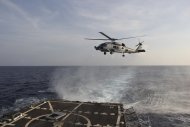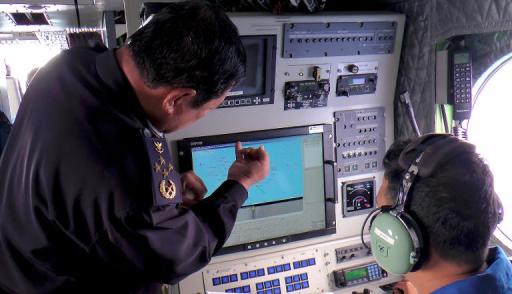 |
|
The Air Force’s secret space plane has been up in orbit for nearly 500 days—a space endurance record. But nearly a year and a half into the mission, the Pentagon still won’t say what the X-37B is doing up there, or when it might come back.
The U.S. Air Force boosted the robotic X-37B atop the nose of an Atlas-5 rocket in December 2012. Since then it’s orbited the Earth thousands of times, overflying such interesting places as North Korea and Iran.
Similar to the Space Shuttle in appearance, the diminutive X-37B is about a quarter the size of the old shuttles. But there are major differences. Lacking a crew, the spacecraft has no cockpit windows. The X-37B has a payload bay about the size of a pickup truck bed.
And while the original Space Shuttle could stay in orbit for up to 17 days—a limitation largely due to the needs of the crew—the first X-37B mission, OTV-1, spent 225 days in space under the guidance of Air Force space flight controllers at Schriever Air Force Base, Colorado. The second mission, OTV-2, handily doubled that number, clocking 469 days in orbit. OTV-3 is currently at 482 days and counting.
Eventually—nobody knows when—the pudgy space plane will glide back down to Earth like the Space Shuttle it resembles, rolling to a stop on an Air Force runway in California.
The X-37B began as a NASA project to build a small, unmanned space plane. NASA handed the project over to the Defense Advanced Research Projects Agency in 2004, but after budgetary problems the program was transferred to the U.S. Air Force Rapid Capabilities Office, which continues to manage the X-37B program. Boeing’s Phantom Works division built two of the X-37B spacecraft.
The U.S. Air Force will not comment on what kind of missions the X-37B does in space. The service, which doesn’t mind talking about the space drone as a technological achievement, clams up when discussing actual missions.
Rumors abound. One of the most popular is the X-37B can sneak up and eavesdrop on other satellites. The idea does have appeal, but skeptics point out the U.S. already has other smaller, harder to track satellites to do just that.
Another rumor is that the X-37B can, like supervillian Ernst Blofeld’s giant clamshell satellite in You Only Live Twice, saddle up to the satellites of other nations and mess with them. Though theoretically possible, the X-37 would have to be launched into an orbit similar to the target’s, and the X-37B’s size makes it easy to track. Even amateur satellite spotters can track the X-37B, and it would be obvious to everyone who had stolen a satellite.
The most interesting—but least likely—rumor is that the X-37B is some kind of orbital bomber, capable of nailing targets from on high. There’s not a whole lot of evidence to back that theory up.
Brian Weeden, a former Air Force officer with the Space Command’s Joint Space Operations Center and now at the Secure World Foundation, believes that the X-37B is primarily a test bed for new technologies. “I think it is primarily an ISR (Intelligence, Surveillance and Reconnaissance) platform for testing new sensor technologies or validating new technologies.” Weeden tells The Daily Beast. “The current OTV-3 on orbit has basically been in the same orbit since launch, with only the occasional maneuver to maintain that orbit. That’s consistent with a remote sensing/ISR mission.”
The X-37B is probably testing technologies that might be incorporated into the spy satellites of the future. New cameras, radars, and other sensors could be tested in space and then brought back to Earth for study. That’s much better than designing them on Earth and then building an enormously expensive spy satellite reliant on untested technology.
That doesn’t mean that OTV-3 isn’t spying on other countries—it probably is. OTV-3’s orbit takes it over all sorts of interesting places, including North Korea, Iran, Pakistan, Afghanistan, and China. The space drone’s sensors are likely could well be getting workouts against real-world targets, from North Korean missile facilities to shipyards where China’s next aircraft carriers are being built.
And although it’s only a guess, one can surmise that, based on the amount of time the X-37B is spending in orbit, those sensors are apparently working pretty well.
If the X-37B is just a test platform, why won’t the Pentagon open up about it? “I don’t think the secrecy surrounding the X-37B program is an attempt by the U.S. government to hide anything nefarious, but rather that it’s driven by bureaucratic inertia,” Weeden says. Addressing the rumors, Weeden points out, “The secrecy surrounding the program makes it difficult for the U.S. government to respond meaningfully to those claims and debunk them.”
The X-37B is a relatively bright spot during a fallow period for the U.S. space program, and Boeing and the Air Force are capitalizing on the program’s success. Boeing is converting the former Orbiter Processing Facility at the Kennedy Space Center, where Space Shuttles were maintained in-between spaceflights, to a one-stop facility designed to refurbish landed X-37Bs and prepare them for spaceflight again.
Boeing has also proposed a larger X-37C, which would be capable of carrying up to six astronauts to and from orbit. This project is likely to get a second look as relations with Russia, the only country currently capable of sending astronauts into space, sour over the situation in the Ukraine.
In the meantime OTV-3 continues to drift overhead, silently orbiting the Earth, doing whatever it does. It’s anyone’s guess when it will be coming back.
@Thedailybeast









